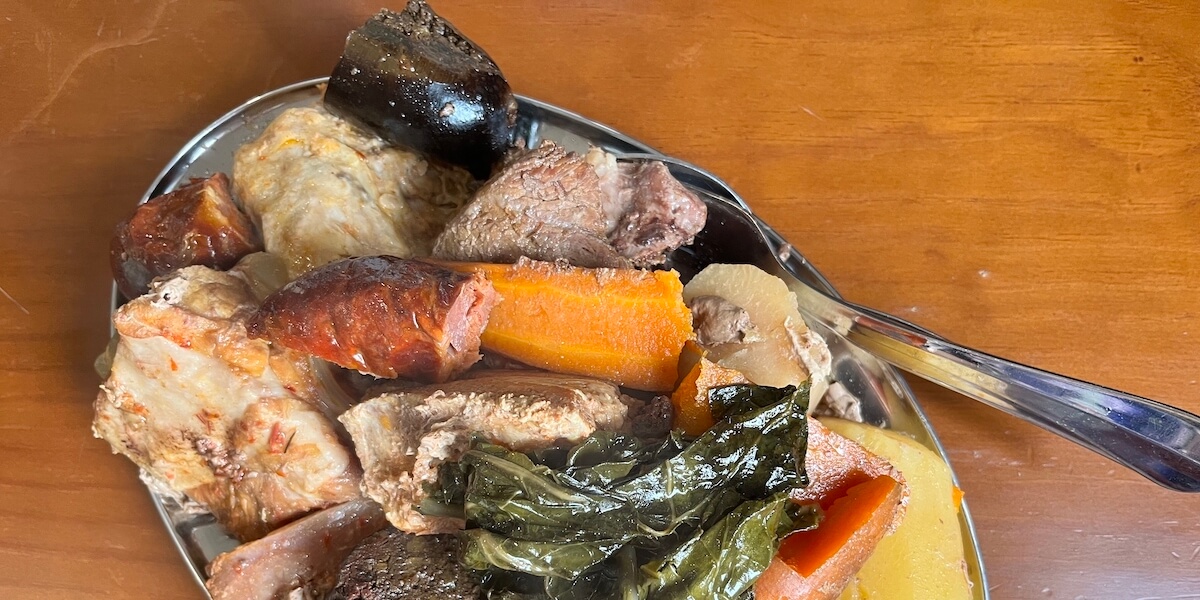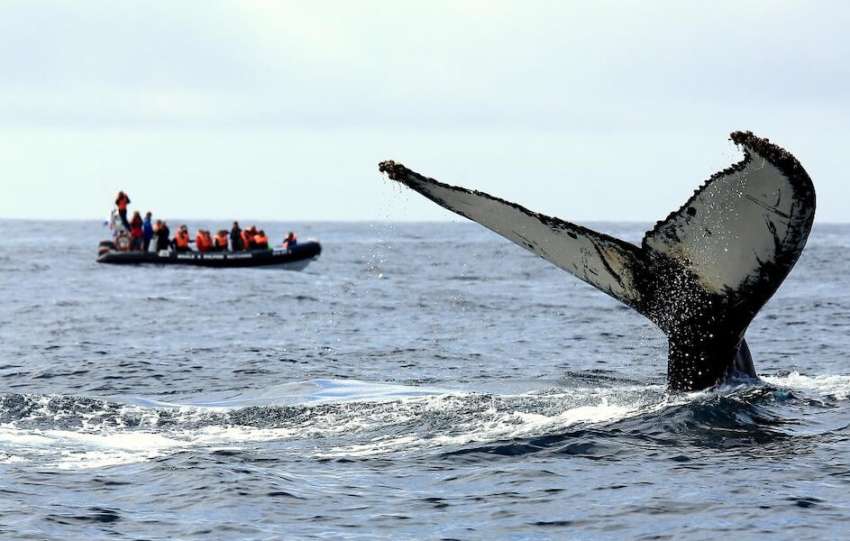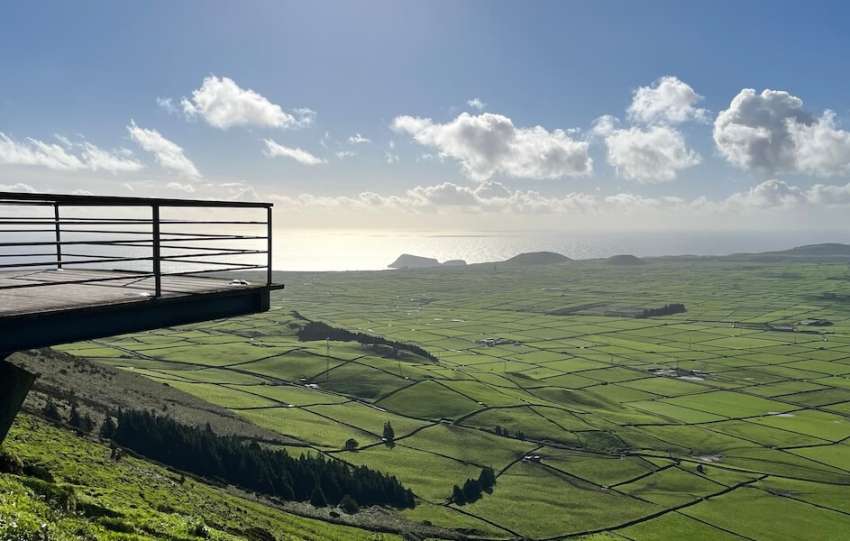Share This Article
If there is one thing worth trying in the Azores is its unique cuisine, influenced by both traditional Portuguese food but also from the food and experiences that its sailors had all around the world, as well as by the ingredients provided by the Atlantic Ocean: its amazing seafood. Indeed, if you are a proper foodie like me, keep on reading to discover what to eat in the Azores to make sure you don’t miss a thing! 🙂
What to eat in the Azores: seafood
Seafood
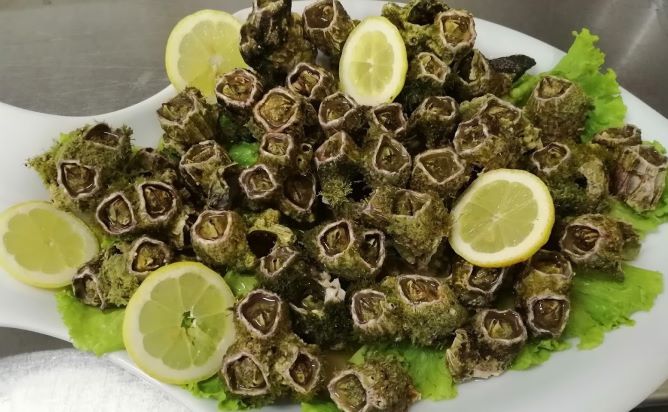
As you can imagine, being in the middle of the Atlantic Ocean, the most obvious answer to the question “What to eat in the Azores?” is “Seafood, you silly!”. You can go for some of the amazing regional dishes I mention below but for me one of the simplest and yet more exquisite experiences you can have in the Azores islands is simply to order different kinds of fresh seafood and enjoy it as a starter with some white wine while enjoying the sunset.
These are my favorite seafood items in the Azores islands:
- Cracas (let’s call them the “Azores cousins” of barnacles. They look hideous but they are damn good!)
- Cavaco (a peculiar looking local lobster caught seasonally around the summertime)
where to eat seafood starters: pretty much all over the Azores islands 🙂
Lapas (Limpets)
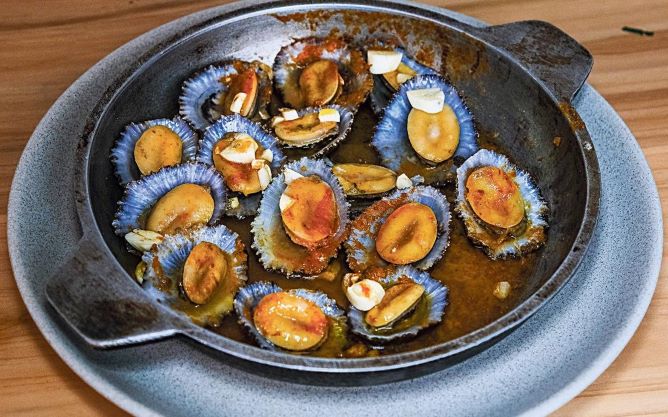
One of the most traditional appetizers that you will find pretty much all across the Azores islands, from fancy restaurants to small cafés around the corner, are lapas. These weird looking crustaceans, known as limpets in English, are cooked in a griddle pan in a sauce of butter, garlic and a chili paste that I particularly hate. To be completely honest (and I am going to be killed by all my local friends), I prefer the lapas from Madeira island, as they are cooked just with butter and lemon.
Nonetheless, they are so popular in the Azores that they couldn’t be amiss on this guide of What to eat in the Azores.
Where to eat lapas: they can be found pretty much anywhere, don’t worry!
Amêijoas de São Jorge (Clams from São Jorge island)

Of the many seafood options that we can eat in the Azores, I would also like to highlight the clams from São Jorge island. Created in the waters of the Fajã de Santo Cristo caldera lagoon, which I already mentioned in my guide to the best hikes on São Jorge island, they are huge and juicy clams, perfect on a summer day.
There are several ways to prepare São Jorge clams, but I personally like them very simple, with an onion and tomato sauce refreshed with white wine. Wonderful!
Where to find amêijoas de São Jorge:
- O Amilcar, in Fajã do Ouvidor;
- Fornos De Lava, near Velas region;
- A Quinta, near Zona Balnear da Ribeira do Nabo;
- “O Borges”, in Fajã da Caldeira do Santo Cristo (this fajã is the only location where this delicious clams thrive, making it the only place to find them!).
Caldeirada de Peixe
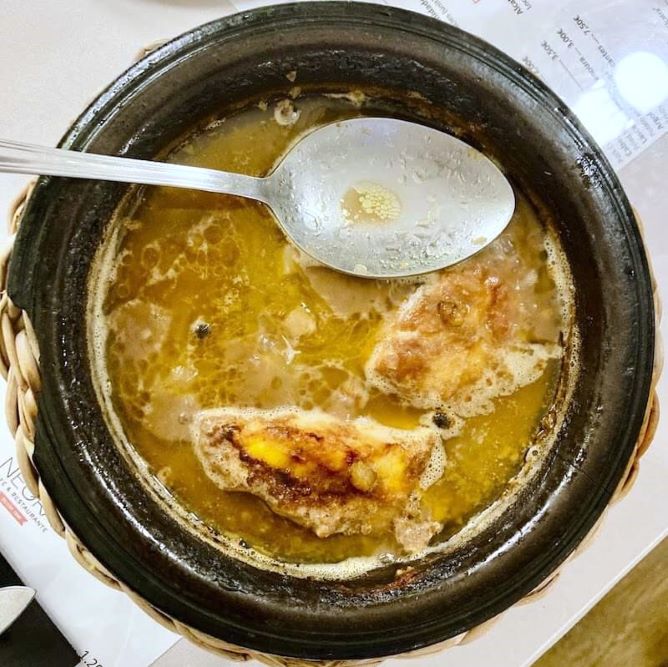
Caldeirada is a Portuguese fish stew consisting of a wide variety of fish, along with other ingredients. A fisherman’s stew, the dish has been described as “a fish muddle that varies from town to town and depends on what the fishermen have managed to catch”.
The typical Azorean stew contains different types of fish, such as grouper, hake, ray and skate. The fish is cut into small pieces and cooked with white wine, spices, peppers, tomatoes, potatoes and onions.
Where to eat Caldeirada de peixe: you can find caldeirada de peixe a bit all over the Azores islands but by far the best one I ever had was at O Pescador, one of the best restaurants in Terceira island.
Polvo guisado (Octopus stew)
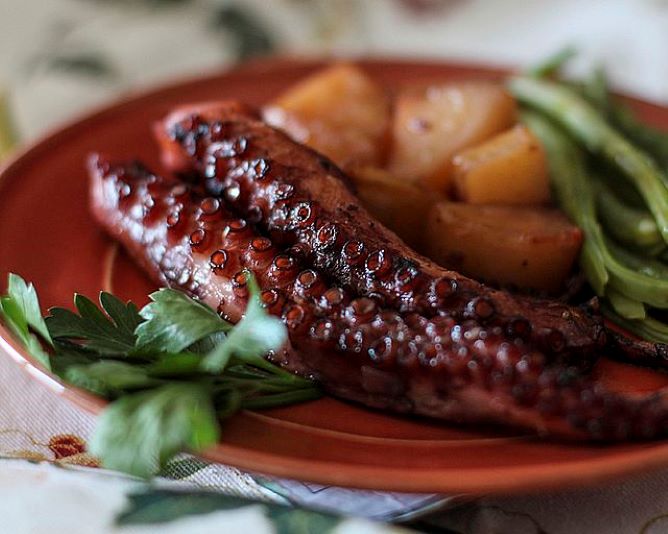
I’m not a big fan of octopus ( because it’s a very intelligent animal that I find difficult to eat), but I confess that I loved the stewed octopus from São Miguel Island because it’s really delicious. Basically, it is an octopus stew made with onions, garlic and red wine, pepper and chili, creating a thick and velvety sauce, served over boiled potatoes.
Where to eat polvo guisado: at “O Américo de Barbosa”, one of the best restaurants in São Miguel island. Take the opportunity to watch the sunset from that area, as it is gorgeous!
Caldeirada de Congro
There is a very specific dish on the island of Flores called Caldeirada de conger, or conger stew. Similar to fish stew, it is made specifically with conger eel, the most common species on Flores Island. It is made from sautéed onion, olive oil, white wine, ground pepper, parsley and chopped garlic cloves. And, obviously, egg yolks beaten with lemon juice are added to the fish. It is served on slices of toasted bread and it is to die for.
What to eat in the Azores: meat dishes
Cozido das Furnas
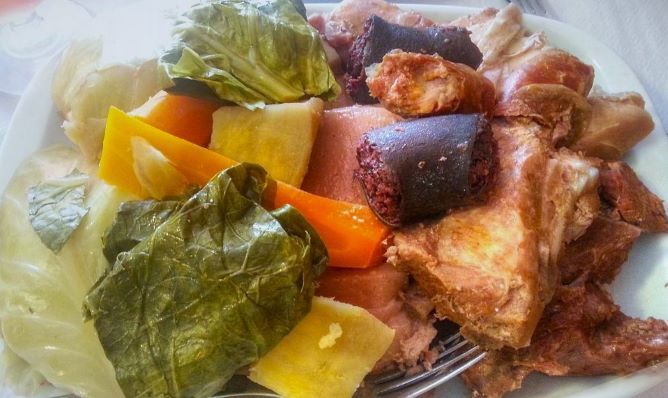
Probably the most iconic dish from the Azores, to eat a proper cozido das Furnas you need to head to one of my favorite places to stay in São Miguel island, Furnas. This cute inland town is particularly famous for its volcanic activity, which “gives birth” to wonderful things such as Dona Beija hot springs and to the amazing opportunity to cook on the ground.
That’s right, you read it correctly: the locals cook a one-pan dish called cozido das Furnas which is basically a stew made from beef rump, pork, chicken, chorizo, smoked bacon, cabbage, potatoes and carrots. Once they are all in a large pan, it is lowered into a pit and buried for 5 hours and voilá!, your meal is ready with minimal effort 😀
I ABSOLUTELY love this unique dish and I would head to Furnas anytime just to have it.
Where to have Cozido das Furnas: in any restaurant in Furnas, really.
Bife regional / local steak
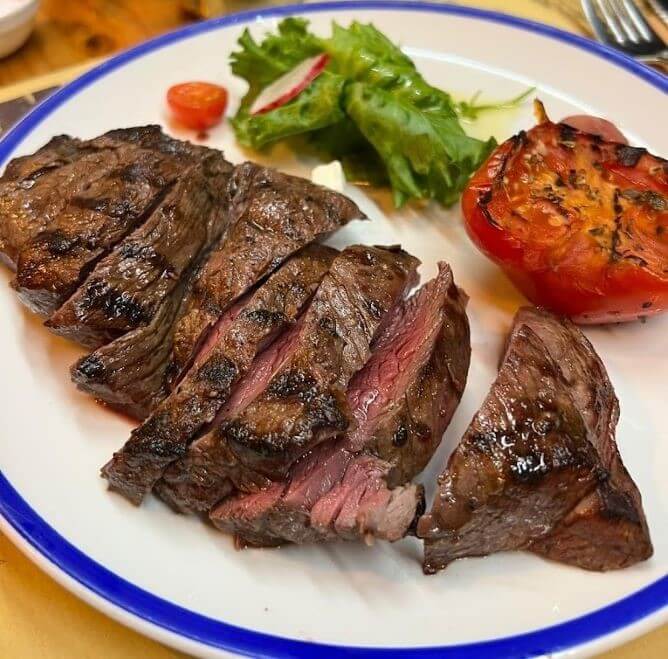
Unless you are a vegetarian, you can’t really go to the Azores islands and miss the opportunity to eat their regional steak, called bife regional. There are different cuts and sauces available, but I like the traditional version, cooked with butter, garlic and the local pepper.
It is a wonderful, simple dish for meat lovers and it is most eaten in São Miguel island.
Where to eat bife regional: check out my list of the best restaurants in São Miguel island.
Alcatra açoriana / beef stew from Terceira island

Alcatra açoriana is a traditional beef stew from Terceira island that uses the less noble parts of the meat, cooked slowly in a clay pot with red wine, onion, garlic, cloves and Jamaican black pepper until tender and falling off the bone. It is absolutely gorgeous and in some restaurants in Terceira island it is even available a fish version of alcatra, even though I am not particularly fond of it.
It is generally served with a sweet brioche bread called massa sovada but I personally prefer to eat it with rice 🙂
Where to eat Alcatra açoriana: Personally, I really like the Alcatra açoriana from a Tasca das Tias, in Angra do Heroísmo, in Terceira island.
Blood sausage with pineapple
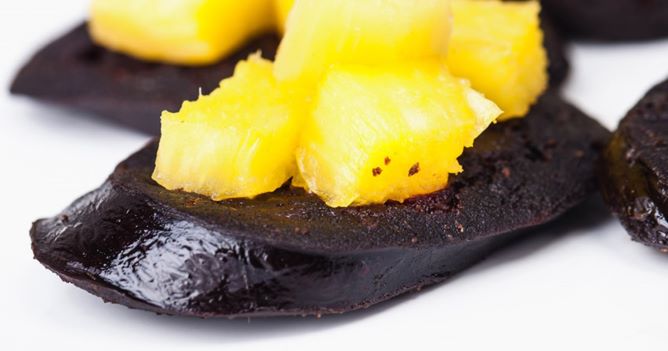
“Blood sausage” is a weird answer to give to the question “what to eat in the Azores?” but trust me, when combined with pineapple it is sooo good. Ask this for a starter and you won’t regret it!
Where to eat blood sausage: it can be found everywhere, don’t worry!
Sopas de Espírito Santo / soup stew
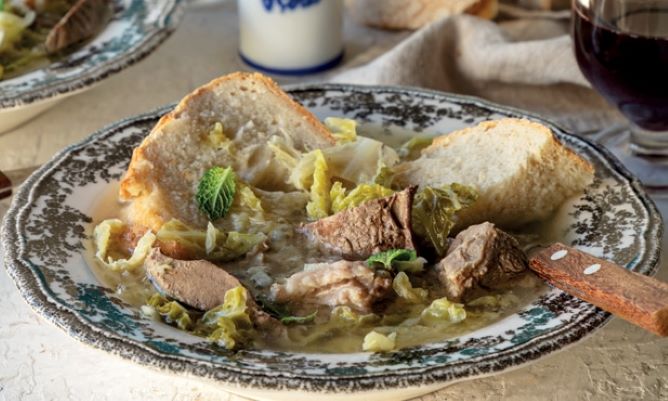
Typical of Espírito Santo festivities, sopas do Espírito Santo is a traditional soup /stew which is present on all the Azores islands. It is generally made with beef, cabbage, homemade wheat bread and mint.
Even though sopas do Espírito Santo are similar from island to island, each of them has its own singularities. On Santa Maria island, they add dill. On Terceira island, Espírito Santo soups contain liver and curdled cow’s blood, which is why it has a more intense flavor (I love it!). On Pico island, sopas do Espírito Santo are seasoned with cumin, cinnamon stick, paprika and allspice, achieving a more wonderful aromatic character.
Espírito Santo festivities take place 50 days after Easter and it usually lasts for 2 weeks, so if you want to try this specific dish you need to plan the dates of your trip to the Azores very carefully and it is not available all year round.
What to eat in the Azores: a sweet tooth guide
Bolo Lêvedo
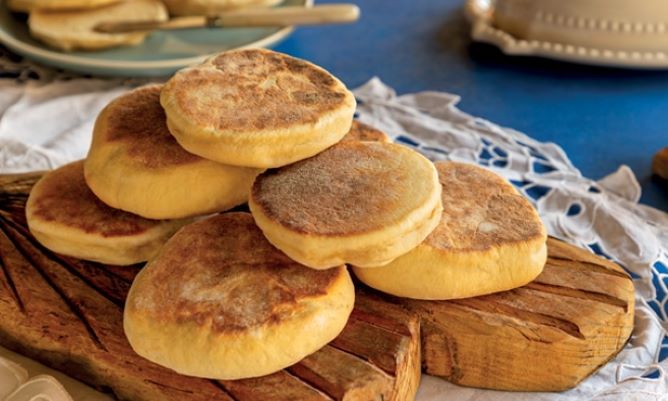
If I could only eat one traditional Azores food for the rest of my life it would probably be bolo lêvedo, because I really, REALLY love this partially bread, partially cake shaped as a regular bun.
Bolo lêvedo is traditionally served with a local burger or with garlic butter, but interestingly enough I LOVE to eat it with butter and any local sweet jam. They can be more commonly found in São Miguel island and in… New England, thanks to the large Portuguese immigrant population there.
Where to try bolo lêvedo: you can usually find it in good snack bars that sell excellent burgers in bolo lêvedo OR you can simply head to local supermarkets in São Miguel and Terceira island. Buy several packages of bolo lêvedo and put it in your suitcase, you won’t regret it!
Queijadas
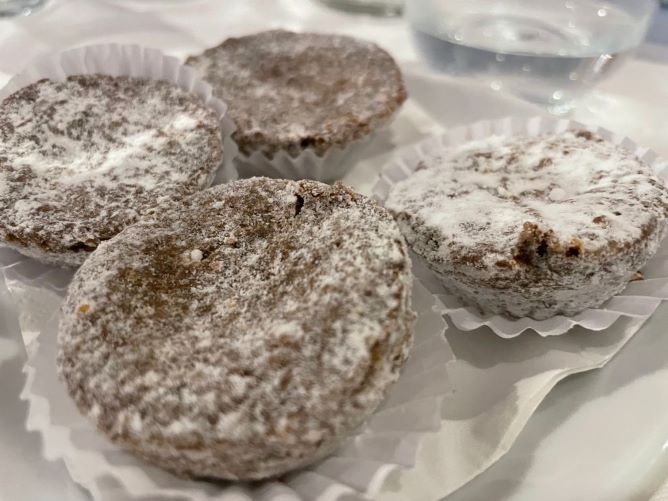
It’s difficult to describe queijadas, one of Portugal’s most traditional sweets, available all over its territory and also, fortunately, on its fortunate islands. Basically, they are small, sweet, cheese-based pastries, and the recipes, like in mainland Portugal, also differ from island to island.
In São Miguel island, the Queijadas de Vila Franca do Campo are the most celebrated. Initially made by nuns in a nearby convent, the pasties are now produced in the village factory. Personally, I don’t like them, as they only taste like sugar to me.
Another of the most famous is the Queijadas da Graciosa, which hail from one of the smaller islands of the same name. Recognizable for their star shape and thin crust, the filling is made from sugar and milk.
BUt my all time favourite queijadas are Donas Amélias, from Terceira island. They look very simple but once you bit them it’s an explosion of spice flavours in your month, as if Christmas came earlier this year. It’s fantastic and you should not miss them!
Where to try Dona Amélia: once you arrive in Terceira island go straight to “O Forno”, a pastry shop in Angra do Heroísmo’s city centre.
Espécies

A typical sweet from the island of São Jorge, espécies are shaped like horseshoes and are made from a very thin dough and cut at the top, so as to reveal the brownish filling, made from stale bread, cinnamon, fennel and allspice. These “cookies” are mind-blowing!
Where to try Dona Amélia: they are available in any pastry shop in São Jorge island but also in all airports / tourist shops.
What to eat in the Azores: wines
The fabulous Pico island wines
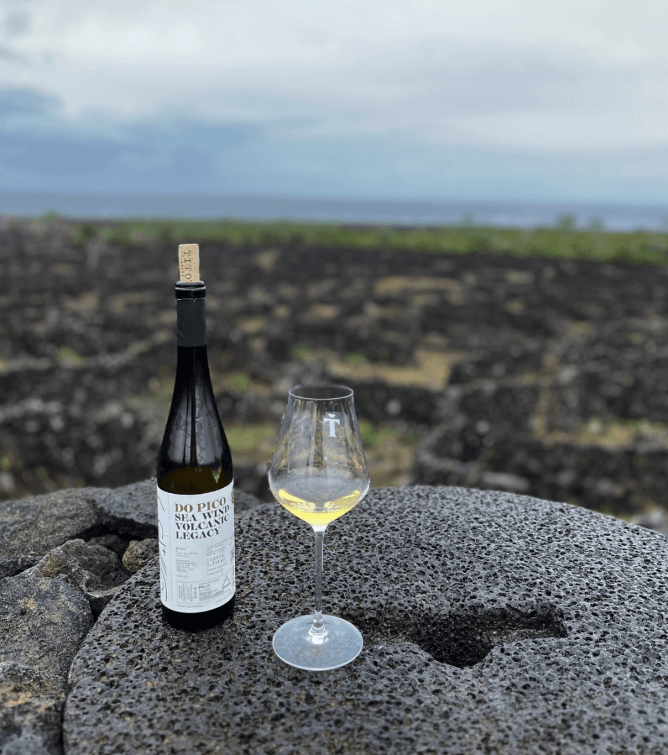
Being an owner of a wine tours business in Porto (Portugal) I am clearly biased towards the wine industry in the Azores. Indeed, some of the most extraordinary white wines I have ever tasted in my life have been in the Azores islands, more specifically in the Pico island.
Mineral, salty and with an exquisite nose, the Pico island wines are indeed a pleasure to try. They are, in general, more expensive than Portuguese wines, due to the rugged terrain (which causes low production per hectare of vines) and to labour shortages, but not more expensive than most European wines.
Therefore, if you are a wine lover I strongly, strongly recommend you to visit some of the best wineries of Pico island. If you can’t visit Pico island this time, do not worry: some of its best wines, notably from Azores Wine Company, A Cerca dos Frades and Insula Wines, are available at the best restaurants in all the islands (but not in continental Portugal, I am afraid). As they are a bit on the expensive side (for Portuguese standards, anyways), don’t expect to find them at all the restaurants in the Azores, but rather at the best ones.
Where to try Pico wines: you can visit some of the best wineries of Pico island or simply head to Cella Bar, a stunning wine bar located by the ocean, also in Pico island.
Kima: an alcohol free option
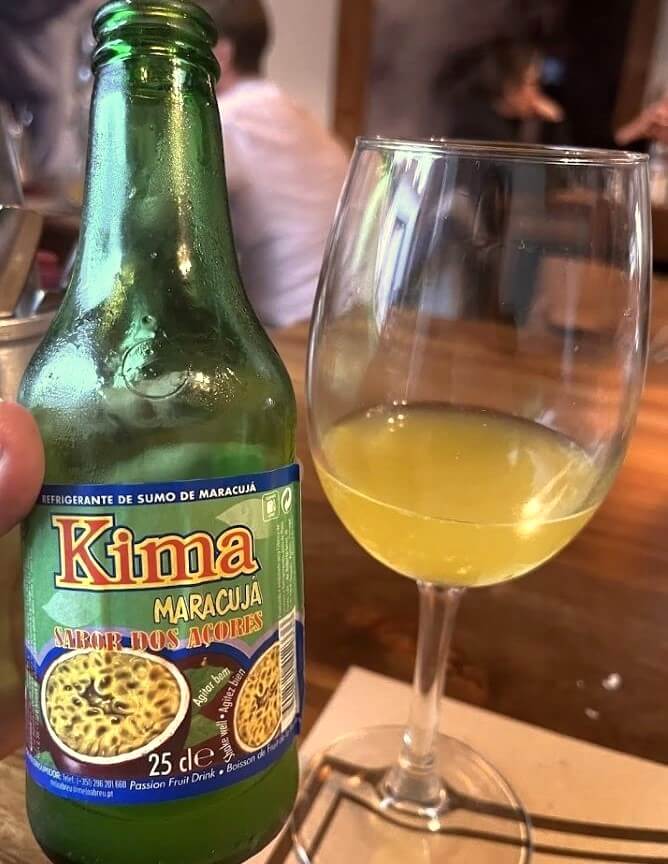
Kids and my teetotal readers alike will be happy to know that there is an alcohol free drink in the Azores islands. It is called Kima and it is a sparkling soft drink made from the local passion fruit. Kima is made from real fruit rather than flavouring, so you will find some pulp at the bottom of the bottle, which gives the drink its distinctive tangy flavour and texture.
You can find Kima pretty much all over the Azores islands, including in supermarkets and in local cafés.

